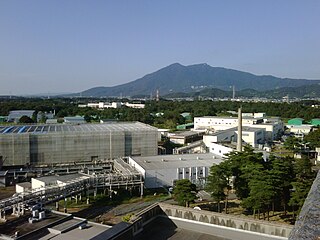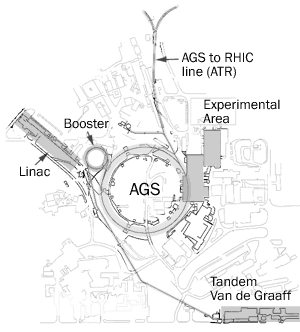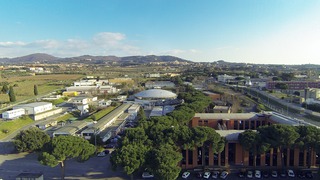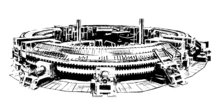
Brookhaven National Laboratory (BNL) is a United States Department of Energy national laboratory located in Upton, Long Island, a hamlet of the Town of Brookhaven. It was formally established in 1947 at the site of Camp Upton, a former U.S. Army base. Located approximately 60 miles east of New York City, it is managed by Stony Brook University and Battelle Memorial Institute.

The Tevatron was a circular particle accelerator in the United States, at the Fermi National Accelerator Laboratory, east of Batavia, Illinois, and was the highest energy particle collider until the Large Hadron Collider (LHC) of the European Organization for Nuclear Research (CERN) was built near Geneva, Switzerland. The Tevatron was a synchrotron that accelerated protons and antiprotons in a 6.28 km (3.90 mi) circumference ring to energies of up to 1 TeV, hence its name. The Tevatron was completed in 1983 at a cost of $120 million and significant upgrade investments were made during its active years of 1983–2011.

James Watson Cronin was an American particle physicist.
ISABELLE was a 200+200 GeV proton–proton colliding beam particle accelerator partially built by the United States government at Brookhaven National Laboratory in Upton, New York, before it was cancelled in July, 1983.

A synchrotron is a particular type of cyclic particle accelerator, descended from the cyclotron, in which the accelerating particle beam travels around a fixed closed-loop path. The magnetic field which bends the particle beam into its closed path increases with time during the accelerating process, being synchronized to the increasing kinetic energy of the particles.

The Relativistic Heavy Ion Collider is the first and one of only two operating heavy-ion colliders, and the only spin-polarized proton collider ever built. Located at Brookhaven National Laboratory (BNL) in Upton, New York, and used by an international team of researchers, it is the only operating particle collider in the US. By using RHIC to collide ions traveling at relativistic speeds, physicists study the primordial form of matter that existed in the universe shortly after the Big Bang. By colliding spin-polarized protons, the spin structure of the proton is explored.

The High Energy Accelerator Research Organization, known as KEK, is a Japanese organization whose purpose is to operate the largest particle physics laboratory in Japan, situated in Tsukuba, Ibaraki prefecture. It was established in 1997. The term "KEK" is also used to refer to the laboratory itself, which employs approximately 695 employees. KEK's main function is to provide the particle accelerators and other infrastructure needed for high-energy physics, material science, structural biology, radiation science, computing science, nuclear transmutation and so on. Numerous experiments have been constructed at KEK by the internal and international collaborations that have made use of them. Makoto Kobayashi, emeritus professor at KEK, is known globally for his work on CP-violation, and was awarded the 2008 Nobel Prize in Physics.

High-energy nuclear physics studies the behavior of nuclear matter in energy regimes typical of high-energy physics. The primary focus of this field is the study of heavy-ion collisions, as compared to lighter atoms in other particle accelerators. At sufficient collision energies, these types of collisions are theorized to produce the quark–gluon plasma. In peripheral nuclear collisions at high energies one expects to obtain information on the electromagnetic production of leptons and mesons that are not accessible in electron–positron colliders due to their much smaller luminosities.

The Proton Synchrotron is a particle accelerator at CERN. It is CERN's first synchrotron, beginning its operation in 1959. For a brief period the PS was the world's highest energy particle accelerator. It has since served as a pre-accelerator for the Intersecting Storage Rings (ISR) and the Super Proton Synchrotron (SPS), and is currently part of the Large Hadron Collider (LHC) accelerator complex. In addition to protons, PS has accelerated alpha particles, oxygen and sulfur nuclei, electrons, positrons, and antiprotons.
The A.I. Alikhanyan National Science Laboratory is a research institute located in Yerevan, Armenia. It was founded in 1943 as a branch of the Yerevan State University by brothers Abram Alikhanov and Artem Alikhanian. It was often referred to by the acronym YerPhI. In 2011 it was renamed to its current name A.I. Alikhanyan National Science Laboratory.

The Alternating Gradient Synchrotron (AGS) is a particle accelerator located at the Brookhaven National Laboratory in Long Island, New York, United States.

The Proton Synchrotron Booster (PSB) is the first and smallest circular proton accelerator in the accelerator chain at the CERN injection complex, which also provides beams to the Large Hadron Collider. It contains four superimposed rings with a radius of 25 meters, which receive protons with an energy of 160 MeV from the linear accelerator Linac4 and accelerate them up to 2.0 GeV, ready to be injected into the Proton Synchrotron (PS). Before the PSB was built in 1972, Linac 1 injected directly into the Proton Synchrotron, but the increased injection energy provided by the booster allowed for more protons to be injected into the PS and a higher luminosity at the end of the accelerator chain.

A particle accelerator is a machine that uses electromagnetic fields to propel charged particles to very high speeds and energies to contain them in well-defined beams. Small accelerators are used for fundamental research in particle physics. Accelerators are also used as synchrotron light sources for the study of condensed matter physics. Smaller particle accelerators are used in a wide variety of applications, including particle therapy for oncological purposes, radioisotope production for medical diagnostics, ion implanters for the manufacture of semiconductors, and accelerator mass spectrometers for measurements of rare isotopes such as radiocarbon.

The Low Energy Anti-Proton Ring (LEAR) was a particle accelerator at CERN which operated from 1982 until 1996. The ring was designed to decelerate and store antiprotons, to study the properties of antimatter and to create atoms of antihydrogen. Antiprotons for the ring were created by the CERN Proton Synchrotron via the Antiproton Collector and the Antiproton Accumulator (AA). The creation of at least nine atoms of antihydrogen were confirmed by the PS210 experiment in 1995.
A Fixed-Field alternating gradient Accelerator is a circular particle accelerator concept that can be characterized by its time-independent magnetic fields and the use of alternating gradient strong focusing.
An energy recovery linac (ERL) is a type of linear particle accelerator that provides a beam of electrons used to produce x-rays by synchrotron radiation. First proposed in 1965 the idea gained interest since the early 2000s.
The NASA Space Radiation Laboratory (NSRL, previously called Booster Applications Facility), is a heavy ion beamline research facility; part of the Collider-Accelerator Department of Brookhaven National Laboratory, located in Upton, New York on Long Island. Its primary mission is to use ion beams (H+to Bi83+) to simulate the cosmic ray radiation fields that are more prominent beyond Earth's atmosphere.

The INFN National Laboratory of Frascati (LNF) was founded in 1954 with the objective of furthering particle physics research, and more specifically to host the 1.1 GeV electrosynchrotron, the first accelerator ever built in Italy. The Laboratory later developed the first ever electron-positron collider: from the first prototype AdA, which demonstrated the feasibility, to the ring ADONE and later on to DAΦNE, still operative today (2024). LNF was also the proposed site of the cancelled particle accelerator SuperB.

The Super Proton–Antiproton Synchrotron was a particle accelerator that operated at CERN from 1981 to 1991. To operate as a proton-antiproton collider the Super Proton Synchrotron (SPS) underwent substantial modifications, altering it from a one beam synchrotron to a two-beam collider. The main experiments at the accelerator were UA1 and UA2, where the W and Z bosons were discovered in 1983. Carlo Rubbia and Simon van der Meer received the 1984 Nobel Prize in Physics for their contributions to the SppS-project, which led to the discovery of the W and Z bosons. Other experiments conducted at the SppS were UA4, UA5 and UA8.
John Paul Blewett was a Canadian-American physicist, known as "a key figure in the development of particle accelerators".




















